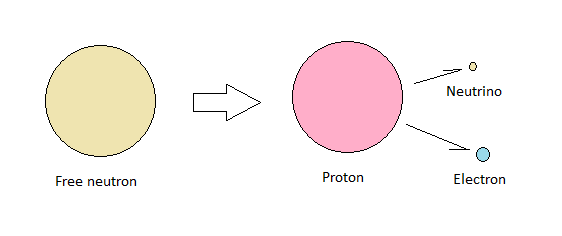We are now in a position to propose an alternative to the accepted idea that electrons hover mysteriously above atomic nuclei. In our physics, where everything happens through direct kinetic interaction, we suggest that electrons do not hover. They bounce:
The bouncing electron
The fact that a free neutron will decay into a proton, electron and anti-neutrino within fifteen minutes tells us that the affinity between protons and electrons is relatively weak. A proton cannot hold onto an electron for very long, and it’s close to impossible to attach an electron to a proton.

If a stray electron bumps into a proton, it will bounce rather than stick. If the bounce is energetic enough, the stray electron continues its journey, leaving the proton behind.
However, if the bounce is too weak to escape the electric field of the proton, the electron comes down again for a second bounce. Unable to escape the electric field, and equally unable to stick to the proton, the stray electron becomes a captive of the proton. Without any added energy, it’s stuck bouncing up and down on the proton. This logic goes for all atomic nuclei because all atomic nuclei carry positive charge. They are all largely abrasive.
Keeping in mind that atomic nuclei are assemblies of protons and electrons, we get that every atomic nuclei has a resonant frequency. This means that any electron captured by an atomic nucleus must bounce at harmonics corresponding to the nucleus’ resonant frequency. Any deviation will be forced back into harmony. Electrons at their lowest energy level, bounce at the resonant frequency of the atomic nucleus. For every vibration of the nucleus, the electron makes a bounce. The next energy level is at the next harmonic, allowing the nucleus to vibrate twice for every bounce. Then we have the next level, where the nucleus vibrates three times for each bounce, and so on until we reach escape velocity.
This explains why captured electrons resonate at discrete energy levels, and why these energy levels are different for different atomic nuclei. It also explains why captured electrons are more likely to be found in certain regions of space relative to the nucleus than other regions.
For atoms with more than two protons in their nuclei, there’s not enough room for all of the electrons to bounce directly off of the nucleus. Only two electrons can do this. Additional electrons bounce off of the repelling electric fields that exist between electrons. These electrons are attracted by the nucleus, but repelled by their fellow electrons. What we get is an atomic nucleus with electrons neatly spaced out in various regions so that every electron is as close as possible to the atomic nucleus and at the same time as far away as possible from their fellow electrons.

Every electron bounces about with a frequency dictated by the atomic nucleus. The inner two electrons bounce directly off of the nucleus. The outer electrons bounce off the electric fields of the electrons closer to the nucleus. Together, this forms a harmonic structure, capable of absorbing end releasing energy in discrete quanta.
A high energy particle that crashes into one of the bouncing electrons will transmit energy to the electron. If the energy transmitted is a little too much, the stray jacket of allowed harmonics comes in, forcing the superfluous energy into the nucleus. The electron will go up any number of energy levels, depending on how much energy is transferred from the particle to the electron.

When the energetic electron at some later time knocks into a low energy photon, everywhere available in the aether, the opposite happens. The photon is kicked up in energy by the energetic electron, and the electron returns to its low energy state.

This is how neon lighting works. However, this isn’t the only way light can be produced. White light is produced differently. White light contains all sorts of energies. Electrons producing white light are therefore randomly yielding energy to photons. This is different from pure neon light, which only comes in narrow and well defined energy spectra.
Chemical bonds
Chemical bonds are formed when atoms find efficient ways to arrange their electrons. In cases where such arrangements are more efficient than the original arrangement, energy is released. Otherwise, energy is consumed in order to produce the arrangement. The subatomic particles involved grow or shrink accordingly.

< Kinetics ———— | ———— The electric force >